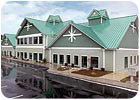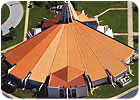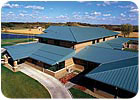
A large number of metal buildings use prepainted galvanized steel sheet for both the roof and wall panels.
Metal buildings comprise almost half of low-rise, non-residential construction, and a large number of these buildings use prepainted galvanized steel sheet for both the roof and wall panels. Prepainted steel sheet is a cost-effective and long-lasting product. In many applications, the proper selection of the paint system (pretreatment, primer and topcoat) can provide painted galvanized steel sheet roofs and walls with a lifespan of 20 years and more. However, to achieve this long service life, the manufacturers of the prepainted steel sheet also must take into consideration a number of other issues, including the nature of the service environment, the thickness and condition of the galvanized steel sheet, the prepainted coil-coating process and the panel design and roll-forming process. Building site issues such as the storage and handling of the roll-formed sheet, the building design, installation practices and field maintenance also can affect the lifespan of prepainted metal building components.

Prepainted galvanized steel sheet has been successfully used for decades in various climates for roofs and walls.
Service Environment Considerations
One of the first considerations in the selection of a prepainted galvanized steel sheet product is the service environment to which it will be exposed.1 The environment encompasses both the general climate of the region - such as the amount and intensity of ultraviolet (UV) radiation, the moisture contact time experienced, the acidity of the rain and the presence of chlorides (near sea coast locations) - and localized effects.The amount and intensity of UV radiation to which the product is exposed is governed by the latitude of the location, the hours per year of sunlight, and the angle of exposure of the prepainted sheet. Obviously, a low angle (flat) roof on a building located in a desert area in the low latitudes requires a primer and topcoat system that is very resistant to UV radiation to avoid premature fading, chalking and cracking. Conversely, UV radiation damage would be of much less concern for vertical wall cladding on a building located in a high-latitude, cloudy climate.
The moisture contact time refers to the length of time the cladding on roofs and walls is wet due to rain, high humidity, fog and condensation. Paint systems are not impervious to moisture. If they remain wet long enough, the moisture will eventually reach the substrate under any paint system, and corrosion will begin. The amount of chemical contaminants, e.g., sulphur dioxide, chlorides, etc., present in the atmosphere will govern the corrosion rate. Some paint systems are more impervious to moisture than others.
Local or micro-climate effects that need to be taken into account include wind direction, pollution fallout from industrial plants and marine environments. Gaseous and particulate exhaust emissions can have a serious effect on paint systems. Within 3 miles of heavy industry, corrosivity can range from moderate to heavy depending on the wind direction and local weather conditions. Beyond 3 miles, the effects associated with pollution fallout from industrial plants are usually reduced.
If prepainted buildings are located close to the sea coast (within 300 yards), the effects of salt water can be severe. Significant effects can be experienced up to 3 miles inland and farther, depending on offshore winds.
If the corrosiveness of a proposed building site is not obvious, an investigation of the local area can be helpful. Data from environmental monitoring stations can provide information on precipitation, humidity and temperature. An examination of unwashed surfaces in protected exposures can indicate whether particulate fallout from industry, roads, marine salts, etc., is a concern. The performance of structures in the immediate vicinity also should be examined. If building materials such as galvanized fences and galvanized or prepainted cladding, roofs, eaves troughs and flashing are in good shape after 10 to 15 years, the environment probably is not aggressive. If structures show distress after only a few years, a cautious approach is justified.
Paint suppliers have the knowledge and experience to recommend paint systems for specific environments.
Galvanized Sheet Considerations
The thickness of the metallic coating beneath the paint has a significant effect on the life of a prepainted sheet in the field, particularly in the case of galvanized steel. At locations where the paint is cut or damaged and the zinc or zinc-based alloy is exposed, lateral undercutting corrosion of the metallic coating will occur. As the coating is consumed by the corrosion reaction, the paint will lose adhesion and peel back or flake off the surface. The thicker the metallic coating, the slower the rate of undercutting corrosion, and the lower the rate of lateral paint delamination.The importance of zinc coating thickness on galvanized steel, especially for roofing, is one reason that many of the manufacturers of galvanized sheet products recommend a G90 [Z275] coating for most prepainted galvanized sheet applications. Another zinc-containing coating used for prepainted steel sheet is 55% aluminum-zinc alloy coated steel, where AZ50 [AZM150] is often the recommended coating, as it has been shown to be adequate for long-term performance.
One aspect to keep in mind is that coil coating operations generally cannot use galvanized sheet that has been passivated with chrome-based chemicals. These chemicals can contaminate the cleaner and pretreatment solutions on a paint line, so the most common practice is to use unpassivated sheet.
Paint System Considerations
One of the most important aspects governing good performance is the paint system used for the job. For example, in areas that receive a lot of sunlight (high UV exposure), it’s important to use a topcoat that is resistant to fading, while regions with significant wetness will require a pretreatment and topcoat that are resistant to moisture penetration. Issues relating to the paint system are best covered by the paint manufacturers and coil coated sheet producers, who possess the knowledge needed to make specific recommendations.2Prepainted Coil-Coating Process Considerations
Another important variable that impacts the life of prepainted products in the field is the manufacture of the prepainted sheet. The prepainted coil-coating process can affect the field performance dramatically. For example, good paint adhesion is important to prevent paint delamination or blistering in the field. Good adhesion requires well controlled coil-coating operating practices. Such practices include:- Adequate cleaning prior to application of the pretreatment
- The proper application of a good chemical pretreatment, appropriate for the end use
- The application of an adequately thick primer and topcoat
- Proper thermal curing of both the primer and paint

In areas that receive a lot of sunlight (high UV exposure), it’s important to use a topcoat that is resistant to fading.
Roll Forming and Panel Design Considerations
The importance of panel design, specifically the bend radii along the formed ribs, is another important issue. As noted previously, zinc corrosion occurs at areas where the paint film is damaged. If the panel design is such that the bend radii are small, there is always the tendency for cracks to develop in the paint coating. Typically, these fissures are small and are often referred to as “micro-cracking.” Nevertheless, any time the metallic coating is exposed, the potential is present for an increased rate of corrosion along the bend radii on a roll-formed panel.The potential for micro-cracking at bends does not mean that deep profiles are not possible. But to accommodate these deep profiles, the design should include as large a bend radius as possible. This aspect of performance involves roll-former design and is well understood by the roll-forming industry.
In addition to the importance of panel and roll-former design, the operation of the roll-former influences the field performance. For example, the alignment of the roll sets influences the actual bend radii. If the alignment is not proper, the bends may develop sharp kinks in the profile bends instead of smooth-flowing, gradual bend radii. These “tight” bends may lead to more severe micro-cracking. Also, it is important that the mating rolls do not abrade the paint coating as this degrades the ability of the paint to accommodate the bending operation.
Spring-back is another relevant issue that needs to be recognized when roll-forming. The usual way to allow for spring-back is to “over-bend” the panel. While this method works, over-bending during the roll-forming operation tends to cause more micro-cracking. Again, the quality control procedures of building panel producers are set up to deal with these issues.
A condition known as “oil canning” or “pocket waves” can sometimes occur on roll formed prepainted steel sheet panels. Panel profiles with wide web or flat areas (architectural profiles) are particularly susceptible. This condition creates an unacceptable wavy appearance when the panels are installed on roofs and walls. While oil canning can be caused by a number of factors,4 including poor incoming sheet flatness, poor roll former operation and poor installation practices, it can also result from elastic buckling of the sheet during forming because compressive stresses occur in the longitudinal direction of the panel. This elastic buckling results because the steel has a low or zero yield-point-elongation (YPE). YPE is the strain associated with discontinuous yielding in the stress-strain curve.
During roll forming, sheet at the bend tries to thin in the thickness and contract in the longitudinal direction. In steel with low YPE, the non-deformed regions adjacent to the bend prevent contraction longitudinally and are placed in compression. Pocket waves occur in the web areas when the compressive stresses exceed the elastic buckling limit stress. Steel with a high YPE improves roll formability because it thins locally at a bend with little transfer of strain in the longitudinal direction. In general, prepainted steel with YPE greater than 4% will roll form satisfactorily. Lower YPE material may roll form without oil canning depending on the roll former setup, steel thickness and panel profile. Oil canning severity decreases as more stands are used to form a profile, as steel thickness increases, as bend corner radius increases and as web width decreases.
If the YPE is higher than 6%, fluting may occur during roll forming. Temper rolling the steel sheet at the time of manufacture will control this effect. Steel manufacturers need to be aware of these issues when they are supplying prepainted sheet for architectural panels so that manufacturing processes can be used that will produce YPE in the acceptable range.
Building Site Considerations
Once the prepainted sheet steel panels arrive at the building site, factors such as improper storage and handling, building design, installation and maintenance can work against their longevity.To prevent corrosion, the uninstalled panels must be stored either inside a building or wrapped in paper under a waterproof tarp so that they remain dry. Additionally, the completed building must be designed to allow all the rain and melting snow to run off, rather than collecting and sitting in contact with the metal. If the application involves the use of fasteners that penetrate through the panels, the fasteners need to be selected so that their life matches the life of the prepainted panel. Today, there are screws/fasteners with an organic coating on their heads that provide corrosion protection and are available in colors to match the roof/wall cladding.
During installation, it is important that shoes or boots worn by workers do not allow small stones, steel drillings, etc., to be embedded into the soles. These materials can scratch the paint, leaving areas susceptible to corrosion. Additionally, all small drillings and/or cuttings (called “swarf”) from the fastening and trimming operations should be immediately removed from the roof. The steel in the swarf will corrode and leave behind a rust discoloration that is objectionable, especially if the paint color is a light tone. Too often, this discoloration is thought to be actual premature degradation of the prepainted panels. In addition to the aesthetic issue, the building owner will need to be convinced that the building is not failing prematurely.
Simple maintenance of the prepainted panels on the building involves washing with water from time to time. This is not usually necessary for installations where the panels experience rainfall such as a roof. But in protected exposure areas, such as the soffit and wall sections beneath eaves, washing every six months is beneficial to remove corrosive salts and debris from the surface of the panels. The cleaning must be done with care, using only nonabrasive detergent and a soft bristle brush or cloth, to avoid scratching the surface. Any cleaning should be done by first “test cleaning” a small surface area in a location that is not boldly exposed to be certain that satisfactory results are achieved.
Trouble-Free Service
Prepainted galvanized steel sheet has been successfully used for decades in various climates for building cladding (roofs and walls). With the proper selection of the paint system, careful building design and regular maintenance, long and trouble-free service can be achieved.For more information about prepainted galvanized steel sheet, visit www.galvinfo.com.
All photos courtesy of The Metal Initiative,www.themetalinitiative.com.

Report Abusive Comment